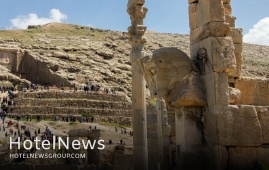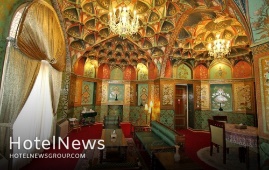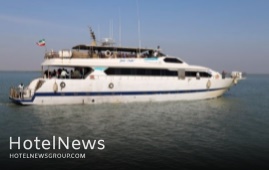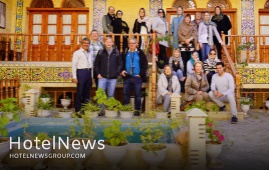
Alphabet’s self-driving car company Waymo is partnering with Chinese automaker Geely to create a fleet of all-electric, self-driving robotaxis. The cars will be designed in Sweden (where Geely owns Swedish carmaker Volvo) and will be adapted from Geely’s all-electric five-door Zeekr. Waymo will then outfit the cars with the hardware and software necessary for autonomous driving. Waymo said in a blog post that it plans to deploy the vehicles in the US as part of its existing fleet of self-driving robotaxis some time “in the years to come.” Concept images of finished vehicle shared by Waymo show a car that is designed specifically for autonomous ride-hailing trips. It has a flat floor, low step-in height, and B-pillarless design for easy entry and exit, as well as sliding doors, reclining seats, and plenty of headroom. Waymo says future models will have an interior without steering wheel or pedals — just a screen (presumably to let riders check on the progress of their journey). These are just concept images, though, and might not necessarily reflect the finished vehicles Geely and Waymo will eventually put on the roads. It’s notable that Waymo’s concepts make the car look much more like a minivan, while Geely’s Zeekr 001 has a design that’s more like a cross between a station wagon, a shooting brake, and an SUV. News of the deal between Geely and Waymo is another demonstration of just how busy the auto world is with partnerships and collaborations as self-driving and electric tech shakes up old incumbents. Waymo has partnered with Stellantis and Jaguar Land Rover to deploy and develop its autonomous capabilities, while Geely plans to take Volvo public as an all-electric company, after doing the same with its new Polestar brand.
Create: Jan 2, 2022 Edit: Jan 2, 2022 International News
Iran's Ministry of Cooperatives, Labour, and Social Welfare has declared Tehran's readiness to dispatch Iranian skilled workforce to Serbia. Director General of the Ministry of Welfare and Social Security for international affairs Hamed Forouzan made the remark in a meeting with Serbian Ambassador to Tehran Dragan Todorović on Wednesday. Referring to long-term political and international relations between Serbia and Iran, Forouzan noted that a draft memorandum of understanding on job creation and vocational cooperation is being finalized and that another MoU on social security is being prepared, which would be inked hopefully concurrent with a visit by Serbian President Aleksandar Vučić to Iran. The Iranian official also invited the Serbian ambassador to pay a visit to the Social Security Investment Company of Iran (SHASTA), adding that the meeting with the ambassador can help facilitate cooperation between Serbian and Iranian economic and trade groups. Forouzan underlined that the Islamic Republic of Iran expects Serbia to support Tehran in international organizations. Todorović, for his part, said that the joint meeting has been held to evaluate the current situation in order to pave the way for expansion of trade ties in different fields such as agriculture and tourism. Emphasizing on the need for facilitating issuance of visa for businessmen of both countries, the ambassador said that the main obstacle in the way of expansion of trade relationship is problems concerning banking transactions. He expressed hope that resolving political issues would pave the way for feasible trade and banking cooperation. Statistics indicate that trade ties between Serbia and Iran boosted in recent years, for instance the economic exchanges stood at 52.3 million dollars in 2018. Iran exported goods worth 42.4 million dollars to Serbia in that year and imported 9.8 million dollars from the European country in the same period.
Create: Jan 2, 2022 Edit: Jan 2, 2022 International News
After years marred by a global public health crisis, many of us are lapping up in-person social gatherings with friends, family and colleagues. Morning catch-ups over coffee, afterwork happy hour at the favorite waterhole or weekend drinks in town had mostly been replaced with coffees-to-go, virtual apéros, or alfresco drinking in winter like in summer. Consumers have become today their own baristas and bartenders, imbibing alone at home or at a distance outside. So how, and with what, will we quench our thirst? Here is EHL’s selection of the top drink trends in 2022. In this pandemic-era, there is no doubt that the megatrends for the new year will center around healthier and ‘cleaner’, more sustainable, premium and socially responsible products in line with the mantras – good for me, good for the planet – and quality over quantity. With movements like mindful drinking and “sober curious” gaining popularity, research indicates that alcohol consumption has declined with younger generations drinking less as they show greater interest in holistic wellness and health. And the beverage industry has been paying attention to these shifts in concern, consciousness and habits. Functional and healthy beverages are on the rise, and no and low alcohol ready-to-drink offerings from North America to Europe and Asia-Pacific have boomed as they prove to be both a more convenient and ‘safer’ option in a world still plagued by COVID-19 measures and barrier gestures. But globally, we’re seeing an array of interesting new product developments, packaging innovations and surprising mergers and acquisitions with the lines between the health movement, the low- and no- alcoholic category and the wider drinks industry becoming increasingly blurred. Beyond these general tendencies, we take a look at six particular drink trends for the year ahead. 1. CBD-infused relaxation drinks For those of us who frequent trendy bars, a controversial yet very 2022 new trend has found its way onto cocktail menus in only the most avant-garde of venues. 2. The bubble tea craze goes global Despite being invented in the 1980s, bubble tea is set to see its popularity soar to new heights. From the US to Germany, China to Brazil, the bubble tea industry is going global with its market expected to grow by almost $2 billion to reach $4.3 billion by 2027. The refreshing Taiwanese tea-based drink with its tapioca or fruit jelly ‘bubbles’ is appealing to health-conscious individuals enjoying the healthier variants low in sugar, with organic soya milk, green tea or fruity mixes as well as a younger generation seduced by its 200 or so different flavor combinations and even more customizable options making for a truly unique, tasty and fun drink. 3. Fermented drinks as a health-booster Increased awareness on the importance of fueling our body with quality and nutritious food and drink is driving a rapid growth in fermented beverages, occupying a significant portion within the functional and healthy drinks category. It’s estimated that probiotic beverages are expected to achieve over $77 billion in sales by 2025, almost double the revenue generated worldwide in 2018. While kombucha has been topping the leader board for some years, it’s now got some serious competition. Water kefir, with its more diverse probiotic strains shown to help boost the immune system and aid digestion, is gaining momentum and creeping into the mainstream. As is the fermented Mexican soda Tepache – another healthy, flavorsome, sustainable alternative to kombucha. While not new in itself, it has promising prospects in this ‘health-conscious’ era, but hey, it’s just a gut feeling! 4. Wines and champagnes with star power Celebrity beverage endorsements are nothing new. Think George Clooney and Nespresso, Jennifer Aniston and Smart Water, or countless sporting stars endorsing energy drinks. But expect to see more and more vineyards and champagne houses partnering with big names to capitalize on their glamorous images and extend their respective brand portfolios. After John Legend, Kylie Minogue or Brad Pitt, Cameron Diaz is the latest celebrity to venture into the wine business with her “clean” wines. The range comprises of an organic and vegan French rosé and Spanish white with no added sugar, with Diaz tapping into both the wellness trend and that of the growing ‘thirst’ for ‘pink’ wine. Such partnerships are also strategic in helping introduce wines and champagnes to new consumers, in particular millennial drinkers drawn to celebrity and wellness lifestyles, and who aren’t impartial to the Instagrammable aesthetic of a fizzy or rose-tinted drink. 5. Boxed wine as a sustainable (and sanitary) choice Did you know that during the COVID-19 pandemic, bag-in-a-box wine was the supermarket alcoholic “go-to” beverage? The draw? Beyond the product within the bag, boxed wine is easier to store, it better preserves open wine, and is proving a more hygienic and sustainable option, in particular for restaurants. With each three-liter box generating about half the carbon dioxide emissions to that of a glass bottle, boxed wine is also cheaper to transport, stock and more environmentally-friendly. Something that even the more premium wine houses can’t ignore. While wine connoisseurs may jump to the conclusion that boxed wine equates to poor quality, industry experts are suggesting that that’s changing, and fast, as sales are forecast to continue surging around the world in 2022. 6. Canned cocktails with premium products While some may have enjoyed following online mixology tutorials to create their own home-made cocktails, many long for the days when original creations were served ready-made for immediate consumption. Well, spirit brands and hotel chains like the Marriott have wasted no time to offer the perfect solution and create a variety of delicious, bartender-quality, ready-to-drink cocktails in cans. Tipped to be the hottest trend in the alcoholic beverage space in 2021, the development of prepared cocktails-to-go has, according to Nielsen Premium Panel data, accelerated 171% in 2020, and shows no signs of slowing down in 2022. With high-quality ingredients, authentic flavors, options between low-calorie, sugar and alcohol or premium spirits, and convenient and sanitary packaging – grab-and-go cocktails are here to stay. 7. Spiked sodas and alcohol-free beers and spirits With interest in low and no alcohol by volume (ABV) drinks skyrocketing over the last few years, more and more people are looking for a middle ground between tee-total and drinker, between functional and indulgent, between high-quality and convenience. Consequently, low and non-alcoholic beverages are flooding the market and is the space to watch. From non-alcoholic beers and premium mocktails by spirit brands to the boom of hard seltzers now spilling over into hard coffees and kombucha – consumers are going to be spoilt for choice. Whether it’s wanting something with less sugar and alcohol, with premium products, looking for a slight ‘kick’ in traditional non-alcoholic beverages or an alternative to beer, this growing category ensures there’s something for every taste bud and type of drinker. Drink trends 2022: a toast to good health As we look to turn our backs on 2021, and raise our glasses to a new year, the question still lingers as to whether the drinking habits developed in a COVID-era will prevail in a post-pandemic world. While there is still so much uncertainty, what is clear is that the increasing consumer interest in health, wellness and mindfulness is shaping the beverage industry as a whole as it seeks to quench this thirst for holistic balance. For being able to choose alcohol-free beverages without having to sacrifice flavors, fizz or authenticity. For indulging in a drink without having to abstain completely. For a return to more simplicity with natural and ‘clean’ products. For drinking less in quantity but better in quality.
Create: Jan 1, 2022 Edit: Jan 1, 2022 Coffee Shop
Authorities of Persepolis have launched an unmanned aerial vehicle (UAV) documentation project to help study and analyze the neighboring lands and properties, which encircle the UNESCO World Heritage site in southern Iran. “A documentation project has been commenced on the closest boundaries of Persepolis to gather needed information to monitor possible changes and interventions in this area,” said Hamid Fadaei, the director of the World Heritage site. The first purpose of this documentary is to prepare a cadastral map of agricultural lands in the first-grade boundaries of Persepolis, and the second purpose is to record the current status of historical monuments, including historical sites and hills that are dotted in that area, Fadaei explained. “In that regard, we operate close-range photogrammetry and UAV in the documentation of architecture monuments…..And the project is expected to become to an end by the yearend (March 20, 2022),” the official noted. Persepolis, also known as Takht-e Jamshid, whose magnificent ruins rest at the foot of Kuh-e Rahmat (Mountain of Mercy) is situated 60 kilometers northeast of the city of Shiraz in Fars province. It was the seat of the government of the Achaemenid Empire, though it was designed primarily to be a showplace and spectacular center for the receptions and festivals of the kings and their empire. Persepolis ranks among the archaeological sites which have no equivalent, considering its unique architecture, urban planning, construction technology, and art. This 13-ha ensemble of majestic approaches, monumental stairways, throne rooms (Apadana), reception rooms, and dependencies is classified among the world’s greatest archaeological sites. The city’s immense terrace was begun about 518 BC by Darius the Great, the Achaemenid Empire’s king. On this terrace, successive kings erected a series of architecturally stunning palatial buildings, among them the massive Apadana palace and the Throne Hall (“Hundred-Column Hall”). According to Britannica, the stone was cut with the utmost precision into blocks of great size, which were laid without mortar; many of them are still in place. Especially striking are the huge columns, 13 of which still stand in the audience hall of Darius I (the Great; reigned 522–486 BC), known as the Apadana, the name given to a similar hall built by Darius at Susa. There are two more columns still standing in the entrance hall of the Gate of Xerxes, and a third has been assembled there from its broken pieces. Narratives say that Persepolis was burnt by Alexander the Great in 330 BC apparently as revenge to the Persians because it seems the Persian King Xerxes had burnt the Greek City of Athens around 150 years earlier.
Create: Dec 29, 2021 Edit: Dec 29, 2021 Regional News
The occupancy rate of hotels in Iran has reached 45 percent, the head of the Iranian Hoteliers Association has announced. Following the planned measures, the occupancy rate of the country's hotels, which had fallen below five percent because of the outbreak of the coronavirus, has reached 45 percent over the past three months, IRNA quoted Jamshid Hamzehzadeh as saying on Sunday. Multiple problems, notably the pandemic, caused a severe impact on the tourism industry, the official explained. Even before the coronavirus outbreak and in 2019, travel was reduced due to heavy rains and flooding across the country, and the hotel industry had to recoup nearly 100 percent of the costs paid for canceled hotel reservations, he added. The Iranian hoteliers have lost 220 trillion rials (about $740 million) over the past two years, he noted. However, some problems have been resolved and the hotels’ condition has improved, he mentioned. Back in October, the official announced that Iranian hotels are ready to receive foreign tourists as the issuance of tourist visas and the flow of foreign tourists from land and air borders would be resumed. Ninety percent of the hotel staff have been vaccinated against the coronavirus, so the hotels are ready to welcome foreign tourists, observing strict health protocols, he said. The main destinations of foreign tourists in Iran are specifically cities such as Mashhad, Qom, Tabriz, Shiraz, Yazd, and Isfahan, and to return to the figure of over eight million incoming tourists before the outbreak of the coronavirus, serious planning is required, the official added. Iraqi tourists will flood the country once the borders open, but attracting tourists from Europe will require some time, he noted. However, he noted that two-thirds of the hotel staff have lost their jobs, he added. Back in September, Hamzehzadeh announced that all employees of accommodation centers across Iran are scheduled to be vaccinated against the coronavirus. “To vaccinate staffs of all accommodation centers, including eco-lodges, apartment hotels, and guest houses, as well as hotels, more coordination with the Ministry of Health is needed,” he added. Back in July, ISNA reported that the tourism industry of the country has suffered a loss of some 320 trillion rials ($1.1 billion) since the outbreak of the coronavirus pandemic. The pandemic has also ruined more than 44,000 jobs in a once budding travel sector of the country, the report added. Experts believe accommodation centers suffered the most as a result of the outbreak of the coronavirus in Iran and its subsequent unemployment and financial losses. Months of steep recession has taken its toll. Many travel insiders, hoteliers, and tour operators have faced big dilemmas such as bankruptcy, unemployment, debts, and the prospects of not being competitive on the international level. Panels of travel experts have mapped out new marketing strategies hoping Iran’s tourism would get back on its feet once again. For instance, the Head of the Iranian Tour Operators Association has said the international tourist flow to Iran will return to normal until 2022. Iran is potentially a booming destination for travelers seeking cultural attractions, breathtaking sceneries, and numerous UNESCO-registered sites. Under the 2025 Tourism Vision Plan, Iran aims to increase the number of tourist arrivals from 4.8 million in 2014 to 20 million in 2025.
Create: Dec 28, 2021 Edit: Dec 28, 2021 Regional News
IHG® Hotels & Resorts, one of the world’s leading hotel companies, is proud to announce the signing of the InterContinental Grenada Resort. The 150-room Caribbean hotel will be built on La Sagesse Beach, approximately 30 minutes from the Maurice Bishop International Airport and the town of St. George’s. The InterContinental Grenada Resort will feature more than 30 private suites, an array of restaurants and bars, a luxurious spa and pool with bar and grill, fitness center, approximately 6,000 square feet of meeting space and a business center. The property is expected to open in 2025. Known as a top-rated tropical destination, La Sagesse Beach is a prime location for guests seeking a relaxing and secluded stay along Grenada’s spectacular southeastern shoreline. Julienne Smith, Senior Vice President, Development IHG, Americas, said: “Guests looking for the best in iconic luxury brands will be treated in style with a stay at InterContinental Grenada Resort. We’re excited to work with Range Developments to bring InterContinental’s elevated experience and world-class service to this Caribbean destination.” Mohammed Asaria, Managing Partner, Range Developments, said: “Whether guests come to experience luxurious spa treatments, relax in our stunning pools, dine at one of the specialty on-site restaurants or visit for a grand celebration, InterContinental Grenada Resort will deliver alluring and memorable guest experiences. We are excited to bring the strength of the InterContinental brand to beautiful Grenada. Range Developments has become the clear market leading Citizenship by Investment developer in the Caribbean with an unparalleled reputation for timely delivery and quality.” InterContinental Grenada Resort will be adjacent to Six Senses La Sagesse, Grenada, another Range Developments property and brand in IHG’s luxury portfolio, which is expected to open in 2023. InterContinental Hotels & Resorts has become synonymous with bold exploration, travel and cultural discovery, having pioneered luxury travel in emerging and well-loved destinations for the past 75 years. There are currently 13 InterContinental Hotels & Resorts in Latin America and 205 open globally, including 73 hotels in the pipeline.*
Create: Dec 22, 2021 Edit: Dec 22, 2021 International News
IHG® Hotels & Resorts, one of the world’s leading hotel companies, has announced the signing of a Management Agreement with Dallah Real Estate Company for a Hotel Indigo Resort in Durrat Al Arus, Jeddah. With this signing, IHG continues to expand its lifestyle portfolio in the country to cater to the future demand from new guest segments, seeking authentic Arabian experiences through Hotel Indigo’s neighbourhood story. No two hotel Indigo can be the same, as each has its own specific neighbourhood story embedded in the design, food and service. Due to open in early 2026, the Hotel Indigo Resort will be located in Durrat Al Arus, a recreational neighborhood north of Jeddah, and will be a leisurely drive away from the main city. The resort will be a part of a mixed-use development project consisting of a budding residential community, vast water frontage and man-made lagoons. Located along the Red Sea Coast, Hotel Indigo Resort in Durrat Al Arus will also be a perfect destination for guests to enjoy an active waterfront. IHG and Dallah Real Estate Company, will work in collaboration with renowned design studios and research agencies to weave the ‘Neighbourhood Story’ into the DNA of the hotel. The unique aesthetics of the resort and its service styles will immerse guests into the authenticity of the destination, its local culture, character and history. Along with boldly-designed 271 rooms, the resort will also feature 50 private pool villas, an expansive wellness facility, and home-grown food and beverage concepts that will not only offer a unique perspective to dining in Saudi Arabia – but also catch the interests of foodies and critics alike. Staying true to engaging with the neighbourhood, Dallah Real Estate Company has also partnered with 17Sixty – a marine adventure company that will enable the guests of Hotel Indigo, and residents of Jeddah, to experience marine flora and fauna like never before, keeping sustainability at its core. The company will also provide thrilling water sports activities to the guests. Speaking on the announcement, Haitham Mattar, Managing Director, India, Middle East & Africa, IHG said: “After debuting the brand in Riyadh, we are delighted to sign our second Hotel Indigo property in the country this year – Hotel Indigo Durrat Al Arus in Jeddah. In line with the Saudi Vision 2030 and the country’s Tourism Strategy, our luxury and lifestyle brands are gaining a lot of interest from our partners and investors. We are confident that upon opening, these properties will be equally popular with domestic and international travelers and will add to the authentic experiences guests will be looking for while visiting Saudi Arabia. We are also honored to once again partner with Dallah Real Estate Company, who boast a great deal of expertise in this sector. Together, we look forward to welcoming our guests to this exquisite property when it opens doors in 2026. ” Abdulaziz M.A Yamani, Managing Director, Dallah Real Estate Company said: “Given IHG’s history and strong legacy in the Kingdom, we are pleased to partner with them to offer our Saudi travellers and international guests a premium and authentic stay experience at Hotel Indigo Durrat Al Arus. The hotel will be positioned as a holistic destination for guests looking for adventure and an experiential stay. We are confident that this partnership will not only offer the best-in-class service to guests but also bring value to the business from IHG’s global systems and loyalty programme.” IHG currently operates 37 hotels in Saudi Arabia across five brands including InterContinental, Crowne Plaza, Holiday Inn, Staybridge Suites and voco. A further 23 hotels are in the development pipeline, due to open within the next three to five years.
Create: Dec 22, 2021 Edit: Dec 22, 2021 International News
MCR — the country’s 4th-largest hotel owner-operator — has acquired a portfolio of six premium-branded hotels in Texas and New Mexico, known as “smile states” for their location and fast-growing markets. Totaling 603 rooms, the acquisition includes two Marriott hotels (a TownePlace Suites and a Fairfield Inn & Suites) and four Hilton hotels (two Hamptons, a Home2 Suites and a Tru). All were built in the last four years and nearly 40% of the portfolio (by room count) is specifically an extended stay, all-suite product designed to cater to longer-term guests. Five hotels are in the Dallas-Fort Worth metroplex, the 2nd-fastest-growing major city in the country. The sixth sits in the arts and culture hub of Santa Fe, New Mexico. Planning your next trip to the South or Southwest? Smile – MCR has you covered! Located in the heart of downtown Fort Worth directly across from the Fort Worth Convention Center, the 120-room Fairfield Inn & Suites by Marriott Fort Worth Downtown is the perfect place to work and play. Opened in October 2017, the hotel features a stunning 20-seat bar, super-fast Wi-Fi and a second-floor patio with city skyline views. Just 5 minutes down Route 377, you’ll find 128 suites with fully equipped kitchens at the TownePlace Suites by Marriott Fort Worth University Area/Medical Center. The hotel is less than 10 minutes away from Texas Christian University, the Modern Art Museum and the Will Rogers Memorial Center. Flying out of DFW Airport? Take your pick! The 94-room Home2 Suites by Hilton Euless DFW West, 79-room Tru by Hilton Euless DFW West and 91-room Hampton Inn & Suites Colleyville DFW West are all just 10 minutes from the 4th-busiest airport in the world. With ultra-plush beds, complimentary hot breakfast and state of the art fitness equipment, you won’t feel far away from home. Further west you’ll find the 91-room Hampton Inn Santa Fe South, an oasis of comfort in the New Mexican desert. Located along State Road 14, the Hampton Inn provides direct access to Santa Fe’s historic downtown. Itching to explore? Check out Meow Wolf, the world-renowned art collective featuring 200-plus artists. Later, catch the sunset by our cozy outdoor fireplace.
Create: Dec 22, 2021 Edit: Dec 22, 2021 International News
Hotels have been around for as long as we can remember, but where in history is the origin of this core sector of the tourism industry? While it might come as a surprise for many, the three oldest hotels in the world are all located in Japan and have been operating for hundreds of years. While Japan can boast this very interesting fact, the real champion of historic accommodation facilities is Europe with a large variety of old hotels. In this context, Tourism Review presents the top 10 oldest hotels on the Old Continent – each country represented by only one hotel. Hôtel Cour du Corbeau (France), est. 1528 Located in the heart of Strasbourg and a stone's throw from the cathedral, the Cour du Corbeau is one of the oldest hotels in Europe, being in operation since the beginning of the 16th century. At the same time, it is also one of the most beautiful architectural ensembles of the Renaissance period. The city-owned hotel offers 63 luxurious rooms to its guest, guaranteeing top-notch comfort and an experience to remember. Hostal dos Reis Católicos (Spain), est. 1499 Owned by the Paradores chain (in the ownership of the Spanish government), the Hostal dos Reis Católicos was built as a royal hospital to accommodate pilgrims traveling to Santiago de Compostela. Today, it continues to welcome visitors from all parts of the world in more than 100 rooms and boasts incredible luxury in the heart of one of Spain’s most important cities. Hotel Damier (Belgium), est. 1398 Located on the Grote Markt square in Kortrijk, Damier boasts an impressive history. The first mention of the hotel dates back to the 14th century, with the building boasting an astonishing Rococo façade from 1769. Today, the hotel offers 65 luxurious rooms that will certainly impress even the more demanding individuals. Hotel De Draak (Netherlands), est. 1397 Founded in 1397 and located in the historic center of Bergen op Zoom, Hotel de Draak is the oldest hotel in the Netherlands. It is possible that the hotel is even older, but a huge fire destroyed the city archives in the same year. It is currently owned by the Hazen family and boasts an impressive 62 rooms which provide the guests with fine comfort and luxury. Zum Roten Baeren (Germany), est. 1387 Labelled as the oldest hotel in Germany, the first mention of the Zum Roten Baeren hotel in Freiburg dates to 1387, with the building itself being one of the oldest ones in the city. The guesthouse has been a social center of the city for years and today it has 25 rooms, 20 employees and the ambition to appeal more to the public with its historic charm. Hotel-Gasthof Löwen (Lichtenstein), est. 1380 The Löwen has been offering its services in the hospitality industry since 1380, thus being the oldest hotel in the country. Today the hotel offers elegantly furnished rooms, organization of events and conferences and provides its guests with a gastronomic experience in the form of a restaurant to top it all off. Gastagwirt (Austria), est. 1380 The family led Gastagwirt hotel has been firmly rooted in Eugendorf, in the Salzburg region, for over 700 years. As early as 1380, the "irrevocable, indispensable and forever hereditary liquor license" was awarded to the guesthouse with a letter and a seal. In the present day, the hotel provides fine accommodation services, but especially some of the best seminar and meeting services and facilities in the country. Hotel Interlaken (Switzerland), est. 1323 Hotel Interlaken in Switzerland is also among the oldest hotels in Europe. It was opened in 1323 and was initially meant to be a guesthouse for visitors of the local monastery, while later it was a part of the administration of the region. Today, the family led hotel offers 55 rooms, event organization and much more in the heart of Switzerland. Hotel Alte Goste (Italy), est. 1142 The Alte Goste hotel has been in operation since the 13th century, although the first innkeeper known by name was Gild Stainer in 1557. The region itself served as one of the most important connections between the Holy Roman Empire and Italy. Today the hotel offers a large variety of rooms and apartments for a carefree stay in the Puster Valley. The Olde Bell Hotel (UK), est. 1135 The Olde Bell, located in the small town of Hurley in England first opened almost 900 years ago in 1135. Initially, it operated as a guesthouse for visitors to the nearby Benedictine Priory, but throughout the time it gained even more importance up to the point when Winston Churchill and Dwight D. Eisenhower met there during World War II. Today the hotel offers 48 rooms that guarantee the guests a historic experience not to be forgotten.
Create: Dec 16, 2021 Edit: Dec 16, 2021 International News
The Member States of the World Tourism Organization (UNWTO) have strongly aligned themselves behind its leadership and vision for the sector. Coming together for the 24th General Assembly in Madrid, Spain, Members from every global region approved the Organization’s Programme of Work and endorsed key initiatives designed to build a more a resilient, inclusive and sustainable tourism. The General Assembly has brought together more than 1,000 delegates from 135 countries, including 84 Ministers of Tourism as well as business leaders, destinations and representatives of key international organizations. Opening the General Assembly, UNWTO Secretary-General Zurab Pololikashvili cited the spirit of solidarity and determination that has defined tourism’s response to an unprecedented crisis. In presenting his Report to Members, he made clear how a focus on collaboration and harmonization of protocols, political advocacy and securing financial support for tourism, have help the sector mitigate the impacts of the pandemic and laid the foundations for tourism’s restart in many parts of the country. UN and International Community Backing Mr Pololikashvili said: “In every global region, the pandemic has made clear the importance of our sector – for economic growth, for jobs and trade, and for protecting natural and cultural heritage. We must make the most of this opportunity – to transform goodwill into concrete support.” Emphasizing the significance of the General Assembly, as well as UNWTO’s elevated stature within the global agenda, United Nations Secretary-General Antonio Guterres welcomed delegates and called for them to work together for a “green, inclusive, sustainable” future. Mr Guterres added: “I commend UNWTO and Secretary-General Pololikashvili and hope the decisions taken at the General Assembly will help restore trust in travel and get the world moving safely do developing economies can reap the benefits of sustainable tourism.” The United Nations Secretary-Generals words of support were echoed by the Director-General of the World Health Organization (WHO) Dr Tedros Adhanom Ghebreyesus, by Rebeca Greenspan, Secretary-General, United Nations Conference on Trade and Development (UNCTAD), by Juan Carlos Salazar Gómez, Secretary-General of the International Civil Aviation Organization, and by Vice-President of the European Commission Margaritis Schinas. Alongside receiving an updated on UNWTO’s activities since the last General Assembly two years ago, Members also benefited from a comprehensive overview of the latest tourism trends, as indicated by UNWTO’s latest data, as well as an updated overview of restrictions on travel worldwide. From the floor of the Assembly, Members from different global regions expressed their solidarity with countries impacted by the continued imposition of travel restrictions. Also in Madrid, Member States voted in person to approve the UNWTO Executive Council’s nomination of Mr Pololikashvili to serve as Secretary-General for a second term. On the back of the strongly favorable vote, Mr Pololikashvili will lead UNWTO from 2022 to 2025. UNWTO Again Welcomes Royal Approval On the eve of the General Assembly, His Majesty King Felipe VI of Spain praised UNWTO’s “outstanding work” leading global tourism, most notably over the past 18 months during the worst crisis in the sector’s history. At a special Royal Gala Dinner, His Majesty also emphasized the importance of tourism for economies and societies, both in Spain and globally, making the sector’s recovery essential for many millions of people.
Create: Dec 2, 2021 Edit: Dec 2, 2021 International News
A carefully planned strategy is needed to promote maritime tourism on Iran’s northern and southern coasts, the deputy tourism minister has announced. The country should focus on developing its maritime tourism sector while preparing upstream documents, Ali-Asghar Shalbafian said, ILNA reported on Monday. Operational measures should be taken with the aim of increasing the motivation of private investors, the official added. “By partnering with the private sector in the maritime industry, and promoting the implementation of executive measures, even if they are small and infrequent, we will increase motivation to work in the field,” he explained. In order for maritime tourism to flourish, there has to be interaction and coordination at all levels of government and the private sector, he noted. Coastal and maritime tourism Over the past couple of years, the Islamic Republic has made various efforts to exploit maritime tourism potential by developing hospitality infrastructures, diversifying sea routes, and drawing private sector investors along its vast southern coasts. Prosperous maritime tourism could help the county to meet its ambitious target of attracting 20 million annual tourists by 2025. It also keeps an eye on tourism developments in the Caspian Sea in the north. Back in February, the Ministry of Tourism and the Ministry of Transport and Urban Development signed a memorandum of understanding (MOU) to develop maritime tourism and make the best use of its potential in the southern and northern coasts of the country. Promoting the culture of using the sea as a tool to increase social vitality, development of coastal activities in the form of environmentally-friendly plans and programs, and creating the necessary grounds for cooperation and exchange of knowledge and information was also among the topics of the agreement.
Create: Nov 30, 2021 Edit: Nov 30, 2021 Regional News
In addition to a mandatory negative PCR test certificate, international travelers visiting Iran should buy coronavirus insurance, a tourism official announced on Thursday. “Foreign tourists must buy coronavirus insurance from authorized companies when entering the country, and if they suffer from the pandemic in Iran, they will be provided with a place and treatment for 14 days,” Esmaeil Barat said, IRNA reported. In addition to providing proof of vaccination or a negative PCR, inbound passengers must have coronavirus insurance, which differs from the routine insurance coverage purchased by all tourists before the coronavirus era, the official explained. Home to countless cultural and natural travel destinations, Iran achieved good growth in attracting foreign tourists over the past couple of years but the epidemic shut down its tourism, as in many other countries, Barat said. Iranian Tour Operators Director Ebrahim Pourfaraj said earlier this month that the restoration of tourism flow to the country is very important for Iranian tour operators and travel insiders. “At the moment, we are not thinking about revenues, but we are looking for the beginning of the tourist flow to the country and renew our links [with international fellows],” Pourfaraj said. His comments came after months of steep recession triggered by massive coronavirus restrictions which led many travel insiders, hoteliers, and tour operators towards bankruptcy, unemployment, debts, and the prospects of not being competitive on the international level. As mentioned by Pourfaraj, Iran has made its best to maintain contact with global tourism markets and companies that worked with Iran in the past, especially since virtual communication and meetings have thrived. “Following the resumption of the tourist visa, visitors from Russia and France have traveled to Iran and we are currently expecting a smaller number of tourists in Iran due to the current situation in the world,” he explained. Last November, the World Tourism Organization announced that international tourist arrivals to Iran plunged 72% during the first eight months of 2020 when compared to 2019, highlighting the severe impact of COVID-19 as the main factor. Even before the pandemic, Iran’s tourism was already grappling with some challenges, on top of those Western “media propaganda” aimed at scaring potential travelers away from the Islamic Republic. Some experts believe Iran is still somehow “unknown” for many potential travelers due to such a “media war”. They, however, consider bright prospects for the tourism sector of the country if it vigorously pursues comprehensive strategies to counter U.S.-led propaganda and strict sanctions, yet does its best to loosen tough travel regulations. Iran is potentially a booming destination for travelers seeking cultural attractions, breathtaking sceneries, and numerous UNESCO-registered sites. Under the 2025 Tourism Vision Plan, Iran aims to increase the number of tourist arrivals from 4.8 million in 2014 to 20 million in 2025.
Create: Nov 27, 2021 Edit: Nov 27, 2021 Regional News
